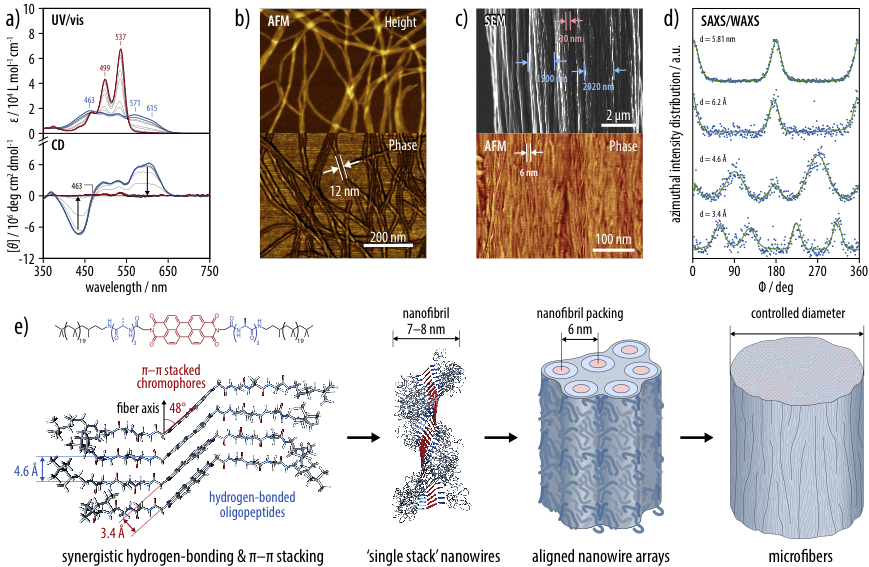Organic Electronic Materials with 1D and 2D Nanostructures
Organic nanowires are model systems for the investigation of charge transport in organic semiconductors under nanoscopic confinement, and may serve as potential building blocks for integrated circuits in the future. However, reliable structure-property relationships between the molecular parameters, the intermolecular π–π interactions, the nature of the charge carriers, and macroscopic transport properties are scarce. We have now established an approach to prepare organic nanowires that consist of exactly one stack of π-conjugated chromophores with a tight intermolecular correlation of the latter due to their hydrogen-bonded substituents. These nanowires exhibit an unprecedented light-induced “self-doping”, resulting in exceptionally high charge densities and band-like transport properties. )
Key Publications. ACS Nano 2018, J. Am. Chem. Soc. 2014, ACS Nano 2013, Chem. Sci. 2012
State of the Research
Well-defined organic nanowires comprising π-conjugated chromophores are of interest for chemical sensors, photovoltaic devices, as well as future nanoelectronic circuits (Jenekhe, Chem. Mater. 2010, 23, 682). Moreover, they may serve as model systems for the investigation of charge generation and transport in organic semiconductors under nanoscopic confinement (Siebbeles, Int. Rev. Phys. Chem. 2008, 27, 87). One-dimensional nanostructures of π-conjugated chromophores have successfully been prepared by controlled anisotropic crystallization from solution (Moore, Acc. Chem. Res. 2008, 41, 1596). The preparation of ‘well-ordered’ organic nanowires with uniform lateral dimensions formed from a defined number of π-conjugated cores per cross-section remains challenging and has only recently been achieved by solution-phase self-assembly of tailored molecules (Parquette, Nanoscale 2012, 4, 6940). In these examples, however, thorough investigations relating macroscopic charge transport properties to well-characterized charge carrier species and, ultimately, molecular parameters that positively affect the π–π interactions between chromophores have so far been the missing link to achieve supramolecular systems with improved charge transport properties. Moreover, the full potential of one dimensional organic nanowires for the preparation of complex electronic devices and their advantages over typical thin film devices need to be explored.
Achievements
We used chromophores substituted with oligopeptide-modified polymers to promote a one-dimensional aggregation promoted by “β-sheet-like” hydrogen-bonding between the oligopeptides. At the same time, supramolecular helicity (symmetry breaking) and polymer attachment (chain extension entropy of the attached polymer segments) served to suppress lateral aggregation. In this way, we developed a reliable model system for the self-assembly of various chromophores (such as perylene bisimides, oligothiophenes, and related compounds) into well-defined nanowires with excellent π–π overlap of the chromophores (Chem. Eur. J. 2020, ACS Nano 2018, ACS Macro Lett. 2012). A detailed structural characterization revealed that the uniform nanowires comprised exactly one single stack of the chromophores at their cores, with remarkably tight π–π stacking that was synergistically enhanced by the hydrogen-bonded side chains (Figure 1). This tight correlation of adjacent chromophores can be regarded as the structural basis for efficient charge generation and transport. Moreover, our comprehensive investigations of the relationship between molecular structure, supramolecular arrangement in the nanowires, spectroscopic properties, and macroscopic charge transport provided the first clear evidence that circular dichroism spectra correlate with the charge transport properties and can thus be regarded as a proxy for efficient charge percolation paths in these nanowires (J. Am. Chem. Soc. 2014). Contradicting simpler assumptions found in the literature, we thus demonstrated that it is not sufficient to prepare one-dimensional aggregates of chromophores in order to obtain nanowires but that the details of the intermolecular arrangement play a crucial role for charge transport.

Conclusions and Outlook
In summary, we developed a reliable system to obtain structurally well-defined organic nanowires that we will now employ to address other major challenges in the field of organic electronics. We have demonstrated that the use of hydrogen-bonded side groups as an additional structure-directing element provides a general avenue for novel organic semiconducting materials with improved morphology and performance. We have already transferred the concept to crystalline thin films of hydrogen-bonded quaterthiophenes and observed high mobilities for this class of semiconductors (Chem. Eur. J. 2020).